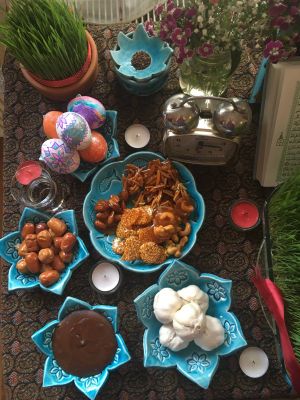Language/Iranian-persian/Culture/Nowruz
What is Nowruz?
Nowruz (also spelled Norooz or Norouz) is the Iranian and Persian New Year, which is celebrated annually on the first day of spring, March 20 or 21. It is a secular holiday that is also celebrated in Afghanistan, Azerbaijan, Iraq, Kazakhstan, Kyrgyzstan, Tajikistan, Turkmenistan, and Uzbekistan. Nowruz is a festival that symbolizes the renewal of nature and the beginning of a new year.
Nowruz has been celebrated for over 3,000 years and is deeply rooted in Iranian and Persian culture. The word Nowruz means "new day" in Persian language, "no" means "new", and "ruz" means "day". The celebration of Nowruz is believed to have originated in Zoroastrianism, the ancient Persian religion that predates Islam and was the official religion of Iran until the 7th century.
Nowruz celebrations usually begin a few weeks before the actual day of Nowruz, with people spring cleaning their homes, buying new clothes, and preparing traditional foods. One of the most important traditions of Nowruz is the Haft-sin table, which is set up with seven items that begin with the Persian letter "sin" (س) that represent health, wealth, wisdom, patience, love, harmony, and beauty. These seven items can include garlic (seer), apple (sib), sumac (somagh), vinegar (serke), wheat or barley sprouts (sabzeh), coin (sekkeh), and mirror (see).
On the day of Nowruz, families gather together and spend time visiting friends and relatives. They also visit cemeteries to pay respects to their ancestors and remember those who have passed away. Children usually receive gifts or money, and everyone enjoys traditional Persian foods such as Sabzi Polo (herb rice), Reshteh Polo (noodle rice), Kashk-e-Bademjan (eggplant dip), and Fesenjan (pomegranate stew with chicken or beef).
Nowruz celebrations continue for thirteen days after the first day of spring. The thirteenth day of Nowruz is called Sizdah Bedar, which is also known as Nature Day. It is a day when people spend time outdoors, have picnics, and throw sprouted wheat or barley into a river or a stream to symbolize getting rid of bad luck and starting anew.
In conclusion, Nowruz is one of the most important celebrations in the Persian and Iranian culture that celebrates the arrival of spring and the beginning of a new year. Its rich tradition and cultural significance continue to be an important part of Iranian and Persian cultural heritage.
Test your knowledge
1. In which countries is Nowruz celebrated?
a. Iran
b. Afghanistan
c. Azerbaijan
d. All of the above
Answer: d. All of the above
2. What does the word "Nowruz" mean?
a. New Year
b. Spring
c. New Day
d. Renewal
Answer: c. New Day
3. Which of the following is not one of the seven items that are typically included in the Haft-Seen table during Nowruz?
a. Coins
b. Saffron
c. Apple
d. Mirror
Answer: b. Saffron
4. What is the significance of the thirteenth day of Nowruz, known as Sizdah Bedar?
a. It is the last day of Nowruz celebrations
b. It is a day to clean the house
c. It is a day to be outdoors and enjoy nature
d. It is a day to visit relatives
Answer: c. It is a day to be outdoors and enjoy nature
5. What traditional Persian dish is usually served during Nowruz?
a. Curry
b. Lasagna
c. Sabzi Polo
d. Tacos
Answer: c. Sabzi Polo

